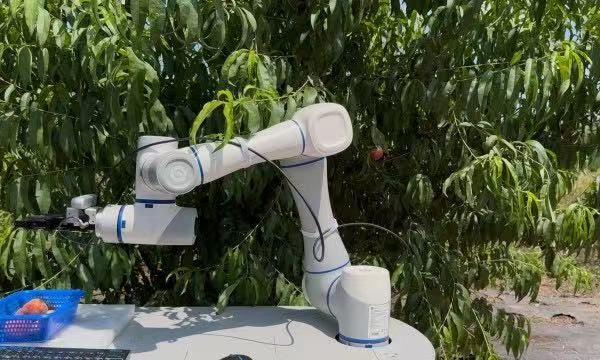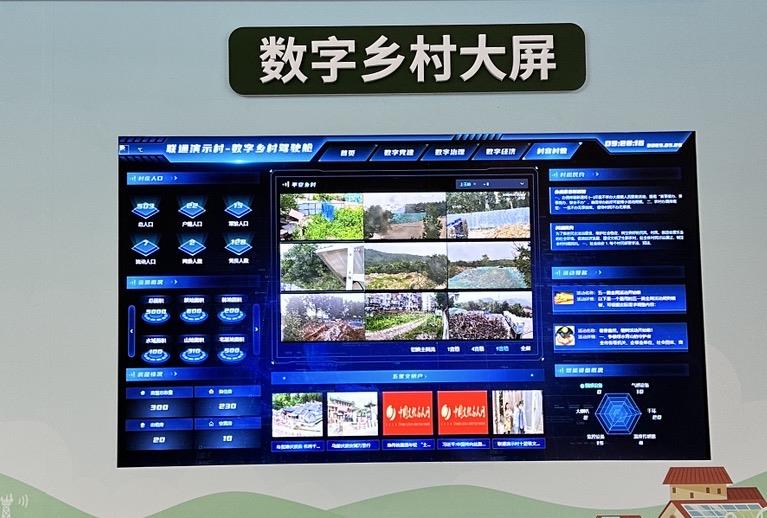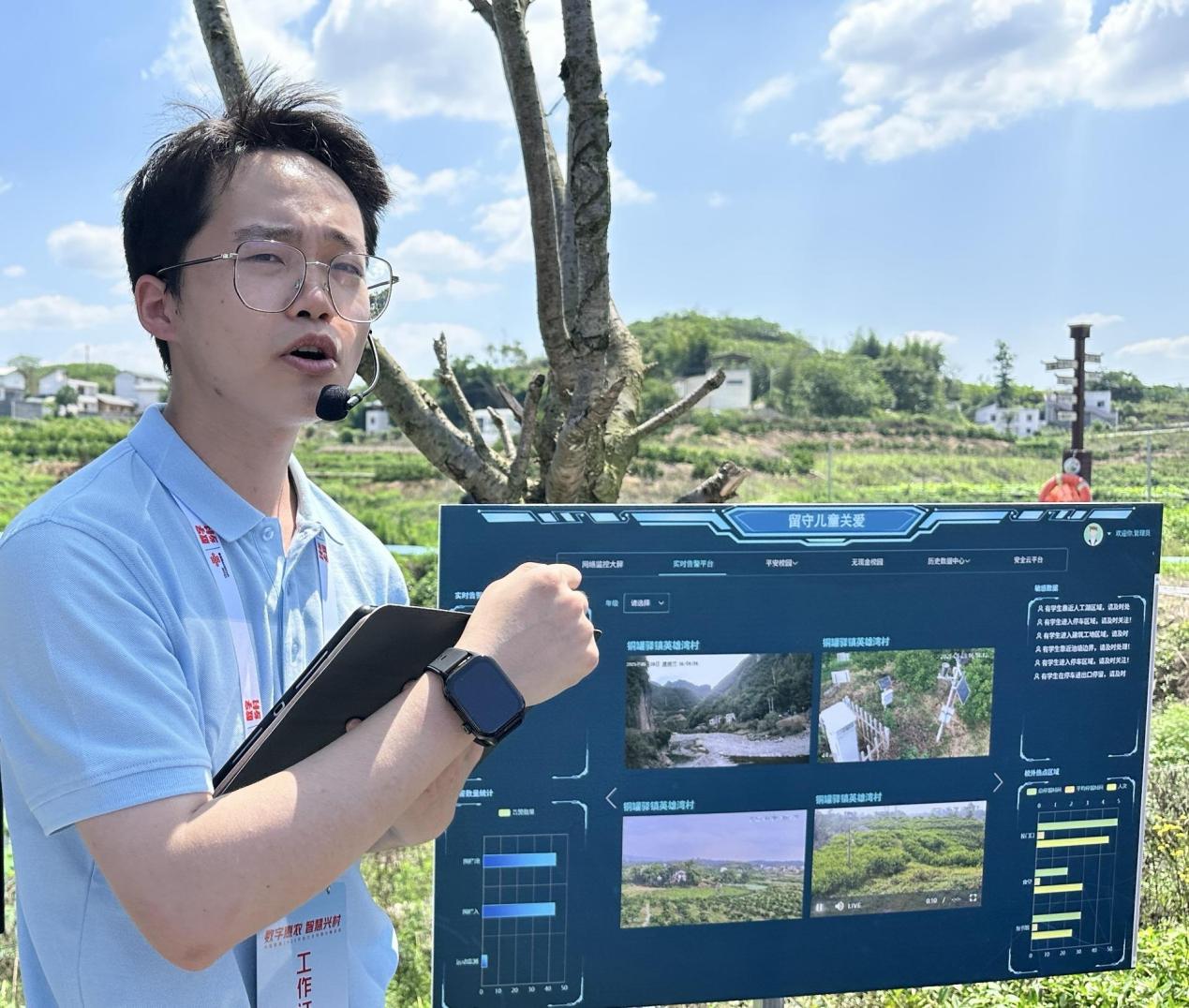
An AI-powered robot harvests peaches in Yingxiongwan village, Tongguanyi township, Jiulongpo district, Chongqing municipality, in southwest China. [Photo by Wu Xiaoli / China Consumer News]
As the summer heats up in southwest China’s Chongqing municipality, a different kind of energy is also taking root within it in Yingxiongwan village, Tongguanyi township, Jiulongpo district – one driven by innovation. Artificial intelligence (AI)-powered robotic arms skillfully harvest ripe peaches beneath the trees in the orchards; drones deliver the fruit down the slopes in the air; and mountain transport robots steadily climb rugged terrain while carrying heavy loads of equipment and supplies. Spearheaded by a major State-owned telecommunications enterprise that has been helping to integrate “technology + a platform + an ecosystem” into daily rural life via a corresponding development model, these scenes reflect a dramatic shift in rural development, and Yingxiongwan has been serving as an exemplary village, symbolizing and epitomizing the model.
Smart agriculture in action
Advances in the Internet of Things (IoT), sensors, and AI are making it possible for farming – once dependent on traditional, labor-intensive techniques – to evolve into highly efficient, data-driven smart agriculture.
Robotic arms with visual recognition systems identify and gently harvest ripe peaches in Yingxiongwan’s orchards. The mountain transport robots handle payloads of up to 300 kg on steep terrain, and smart inspection robots equipped with multispectral sensors and 5G connectivity monitor soil moisture and plant health in real time, helping to guard and protect the orchards. Drones, part of a growing low-altitude logistics system, help overcome transportation challenges associated with hilly and mountainous farmland by quickly ferrying the fruit downhill. This digital toolkit has greatly enhanced harvest efficiency and solved long-standing logistical challenges pertaining to rough, sloped terrain.
According to a representative from the Jiulongpo branch of the telecommunications enterprise that is involved, the AI Crop Clinic – a function of the platform that has been implemented – uses sensor data and images of crops uploaded by farmers to quickly diagnose plant diseases and pest-related issues and provide tailored treatment recommendations. For centuries, farming in China has relied on the experiential knowledge of seasoned farmers. Now that knowledge is being digitized and enhanced through intelligent systems.

A view of the interface associated with the smart village platform that has been implemented in Yingxiongwan. [Photo by Wu Xiaoli / China Consumer News]
Digital platform bridges production and sales
Tongguanyi has been implementing a comprehensive digital platform that integrates four core areas – production, sales, daily life, and AI applications – in partnership with the Jiulongpo branch of the telecommunications operator that has been contributing to the undertaking in its villages in order to foster smart agriculture and upgrade them to smart villages.
On the production side, farmers are now able to manage their orchards via the cloud-based platform. The system provides data-driven tools that help facilitate precision irrigation and intelligent fertilization for citrus and peach crops. The integration of cloud computing and big data helps reduce agricultural input costs while improving fruit quality.
On the consumer side, the platform ensures full transparency and traceability. Every stage of the agricultural process is monitored in real time via visualized data dashboards. Consumers can trace the journey that their food makes from orchard to table by simply scanning a QR code, which builds trust and adds value. This digital model also functions as a scalable and replicable template for smart agricultural development across China.

The digital platform that is used in Yingxiongwan helps facilitate various services related to areas such as farming and governance throughout the village. [Photo by Wu Xiaoli / China Consumer News]
Ecosystem-driven smart village governance
“Student approaching the lake – please respond!”
Alerts such as this one, which come from an AI-powered child-safety monitoring system, exemplify how smart governance is becoming embedded in Yingxiongwan.
Beyond agriculture, the Jiulongpo branch of the telecommunications company that is involved has been implementing smart governance systems and collective economy initiatives in collaboration with local authorities, which has been transforming the village into a flagship hub for AI applications in rural China.
A custom-built platform covering functions ranging from land management and product traceability to financial supervision, asset oversight, and agritourism known as the Jiulongpo Digital Rural Map integrates data from 38 villages and 15 municipal-and national-level agricultural systems, streamlines government services, and reduces the need for people to make in-person visits formerly associated with many tasks.
Yingxiongwan benefits from strong infrastructure as well. It features full 5G and gigabit broadband coverage, and cutting-edge technologies, such as low-altitude IoT networks and satellite-enabled mobile connectivity, are also being rolled out.
Residents have access to a wide range of AI-driven services, including what are known as the Village Committee AI Assistant, the AI Legal Advisor, and the AI Medicine Tool, in addition to the AI Crop Clinic. Featuring seamless urban-rural digital connectivity, these services offer solutions that are both convenient and advanced and have been reshaping grassroots governance.
The AI Assistant acts as a smart steward that helps people manage administrative tasks more efficiently. A points-based governance system also encourages public engagement, and tourists can explore the village using a unified QR code system. Emergency broadcasts provide timely updates, and smart public transport and security systems strengthen community safety. The platform that has been implemented in the village also connects with Chongqing’s broader smart governance networks and public security platforms, creating a multi-layered digital management structure.
The integrated “technology + a platform + an ecosystem” model that has been utilized in Yingxiongwan is more than just a rural success story – it’s a glimpse into the future of rural development. Combining intelligent technologies, unified digital infrastructure, and an innovation-oriented ecosystem of services and governance has made it possible for the village to successfully realize cloud-based production, online sales, digital lifestyles, and AI-driven community management.